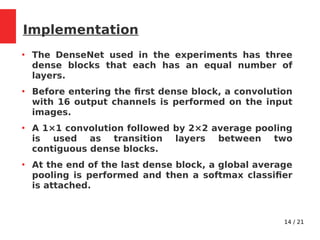Densenet CNN
- 1. Densely Connected Convolutional Networks Authors: Gao Huang*, Zhuang Liu*, Laurens van der Maaten, Kilian Q. Weinberger Presented by: Arun Kumar (ENG18CS0047) Ananth Desai (ENG18CS0034) Evans Nikith Royan (ENG18CS0054)
- 2. CNN Convolutional neural networks (CNNs) have become the dominant machine learning approach for visual object recognition.
- 3. CNN As CNNs become increasingly deep, a new research problem emerges: as information about the input or gradient passes through many layers, it can vanish and “washout” by the time it reaches the end (or beginning) of the network. This problem is addressed by Resnets and by Highway networks. The combination of features using summation may impede the information flow in the network.
- 5. Resnet, Stochastic Depth, Densenet Applications of Resnet: image recognition, localization, and object detection Stochastic depth: Better training of Resnet by dropping layers randomly during training. There is a great amount of redundancy in deep (residual) networks. There are direct connections from any layer to all subsequent layers in Densenet. A traditional CNN with L layers contains L connections. A densenet with L layers contains L*(L+1)/2 connections.
- 6. Formula for Output at Each Layer Consider a single image x0 that is passed through a CNN. The network comprises L layers, each of which implements a non-linear transformation Hℓ(·), where ℓ indexes the layer. Hℓ(·) can contain operations such as BN, ReLU, Pool and Conv. In traditional CNN, In Resnet, In Densenet,
- 7. Hℓ(·) is a Composite Function
- 8. DenseNets DenseNet layers are very narrow (eg: 12 filters per layer), adding only a small set of feature- maps to the “collective knowledge” of the network and keep the remaining feature-maps unchanged; the final classifier makes a decision based on all feature-maps in the network. DenseNets exploit the potential of the network through feature reuse. Inception networks also concatenate features from different layers.
- 9. 9 / 21 Pooling Layers The concatenation operation is not viable when the size of feature-maps changes. Pooling can be either max-pool or average-pool and reduces the size of the feature-maps. To facilitate down-sampling in the architecture the network is divided into multiple densely connected dense blocks with pooling layers inserted between them.
- 10. 10 / 21 Growth Rate ● If each function Hℓ produces k featuremaps, it follows that the ℓth layer has k0 +k ×(ℓ−1) input feature-maps, where k0 is the number of channels in the input layer. ● k is referred to as the growth rate of the network. ● The growth rate regulates how much new information each layer contributes to the global state. The global state, once written, can be accessed from everywhere within the network and, unlike in traditional network architectures, there is no need to replicate it from layer to layer.
- 11. 11 / 21 Bottleneck layers ● Although each layer only produces k output feature-maps, it typically has many more inputs. ● A 1×1 convolution can be introduced as bottleneck layer before each 3×3 convolution to reduce the number of input feature-maps, and thus to improve computational efficiency.
- 12. 12 / 21 Bottleneck layers
- 13. 13 / 21 Compression ● To further improve model compactness, the number of feature-maps is reduced at transition layers. ● If a dense block contains m feature-maps, we let the following transition layer generate [θm] output feature maps, where 0 < θ ≤1 is referred to as the compression factor.
- 14. 14 / 21 Implementation ● The DenseNet used in the experiments has three dense blocks that each has an equal number of layers. ● Before entering the first dense block, a convolution with 16 output channels is performed on the input images. ● A 1×1 convolution followed by 2×2 average pooling is used as transition layers between two contiguous dense blocks. ● At the end of the last dense block, a global average pooling is performed and then a softmax classifier is attached.
- 15. 15 / 21 ADVANTAGES OF DENSE CONNECTIVITY ● ADVANTAGE 1: STRONG GRADIENT FLOW
- 16. 16 / 21 ● ADVANTAGE 2: PARAMETER & COMPUTATIONAL EFFICIENCY
- 17. 17 / 21 ● ADVANTAGE 3: MAINTAINS LOW COMPLEXITY FEATURES
- 18. 18 / 21
- 19. 19 / 21 RESULTS ● Results on CIFAR-10:
- 20. 20 / 21 ● Results on CIFAR-100:
- 21. 21 / 21 ● Results on IMAGENET












![13 / 21
Compression
●
To further improve model compactness, the number
of feature-maps is reduced at transition layers.
●
If a dense block contains m feature-maps, we let
the following transition layer generate [θm] output
feature maps, where 0 < θ ≤1 is referred to as the
compression factor.](https://image.slidesharecdn.com/ppt-210410130657/85/Densenet-CNN-13-320.jpg)







